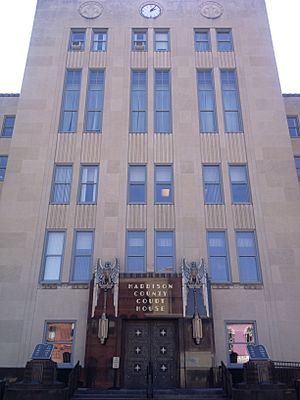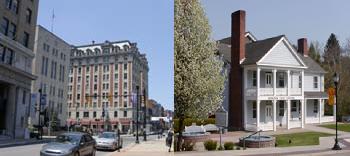Harrison County, West Virginia facts for kids
Quick facts for kids
Harrison County
|
||
|---|---|---|
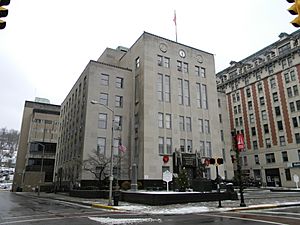
Harrison County Courthouse
|
||
|
||
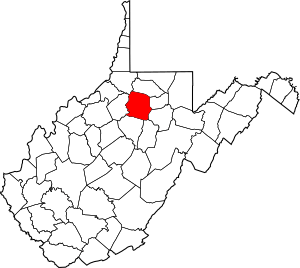
Location within the U.S. state of West Virginia
|
||
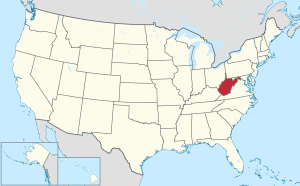 West Virginia's location within the U.S. |
||
| Country | ||
| State | ||
| Founded | May 3, 1784 | |
| Named for | Benjamin Harrison V | |
| Seat | Clarksburg | |
| Largest city | Clarksburg | |
| Area | ||
| • Total | 417 sq mi (1,080 km2) | |
| • Land | 416 sq mi (1,080 km2) | |
| • Water | 0.5 sq mi (1 km2) 0.1%% | |
| Population
(2020)
|
||
| • Estimate
(2021)
|
65,158 |
|
| Time zone | UTC−5 (Eastern) | |
| • Summer (DST) | UTC−4 (EDT) | |
| Congressional district | 1st | |
Harrison County is a county in the U.S. state of West Virginia. As of the 2020 census, the population was 65,921. Its county seat is Clarksburg. Harrison County is part of the Clarksburg, WV Micropolitan Statistical Area.
History
Indigenous peoples lived in the area that would become Harrison County for thousands of years. The Oak Mounds outside Clarksburg were built by the Hopewell culture mound builders during the first millennium CE.
18th century
White trappers visited the area that is now Harrison County as early as the 1760s. Some traded with the Native Americans of the area. The Virginia Colony claimed the area as part of its vast Augusta County. The first permanent settler in the area was hunter and trapper John Simpson, who erected a cabin at the mouth of Elk Creek on the West Fork River in 1763 or '64. Simpson's name remains on "Simpson's Creek" (its mouth is about 9 miles downstream from present Clarksburg). Settler Daniel Davisson (1748–1819), from New Jersey, claimed the land upon which present-day Clarksburg, Harrison County, was formed in 1773; the area was re-designated as part of Monongalia County, Virginia three years later. Simpson's story did not end well. According to a 19th-century local historian, he ...
... continued to hunt and trap for a year without encountering any other human being. In 1765, he went to the South Branch to dispose of a stock of skins and furs, and returning to his camp, remained until permanent settlements were made in the vicinity. ... Simpson's cabin was located about one mile from Clarksburg, on the west side of the West Fork River ... Simpson became indebted to a man named Cottrial to the amount of "one quart of salt" (a precious article at the time), which he agreed to pay, either in money or salt, upon his return from Winchester, whither he was going to dispose of a stock of skins and furs. Upon his return, a dispute arose between them, regarding the payment, and Cottrial, in the heat of passion, hastened from the house, and grasping Daniel Davisson's gun, which stood leaning against the cabin, took aim through the space between the logs, and attempted to shoot Simpson. The latter, however, was too quick for him, and springing outside, grasped the gun from Cottrial's hands and killed him. This was the first tragedy of this nature in the vicinity.
Harrison County was organized in 1784, with territory partitioned from Monongalia County. It was named for Benjamin Harrison V, who had recently retired as the Governor of Virginia. (He was the father of William Henry Harrison, 9th President of the United States and great-grandfather of Benjamin Harrison, 23rd president.) Over the next 72 years, all of eight present-day West Virginia counties and parts of ten others were formed from this original Harrison County.
The first meeting of the Harrison County court was held on July 20, 1784, at the home of George Jackson. The group designated the county seat as Clarksburg. The town, named for explorer General George Rogers Clark (1752–1818), was chartered by the Virginia General Assembly in October 1785, and it was incorporated in 1795.
19th century
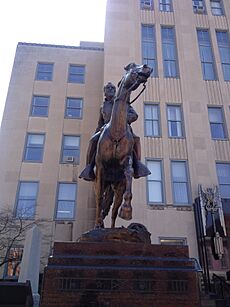
Clarksburg's first newspaper, The By-Stander, began publication in 1810. Construction of the Northwestern Turnpike connecting Winchester and Parkersburg, reached the town in 1836, stimulating development by connecting it to other markets. Clarksburg's economic development was also helped by the arrival of the Baltimore and Ohio Railroad in 1856. The railroad was instrumental in the development of the local coal mining industry during the late 1800s and early 1900s.
In 1863, West Virginia's counties were divided into civil townships, with the intention of encouraging local government. This proved impractical in the heavily rural state, and in 1872 the townships were converted into magisterial districts. Harrison County was divided into ten districts: Clark, Clay, Coal, Eagle, Elk, Grant, Sardis, Simpson, Tenmile, and Union. These districts remained stable for a century, but in the 1970s they were consolidated to form six new districts: North Clarksburg, South Clarksburg, Suburban, Northern, Southeast, and Southwest. In the 1980s, North and South Clarksburg Districts became North Urban and South Urban. In the 1990s, the Southeast and Suburban Districts were discontinued, and replaced by the Eastern and Southern Districts.
Geography
The county terrain consists of low rolling hills, largely wooded, etched by drainages and creeks. The terrain slopes to the West Fork River valley from both east and west borders, and also generally slopes to the north. Its highest point is on its south corner, at 1,736 ft (529 m) ASL. The county has a total area of 417 square miles (1,080 km2), of which 416 square miles (1,080 km2) is land and 0.5 square miles (1.3 km2) (0.1%) is water. The county is drained by the north-flowing West Fork River and its tributaries, including Tenmile Creek, Simpson Creek, and Elk Creek.
Major highways
 Interstate 79
Interstate 79 U.S. Route 19
U.S. Route 19 U.S. Route 50
U.S. Route 50 West Virginia Route 20
West Virginia Route 20 West Virginia Route 23
West Virginia Route 23 West Virginia Route 57
West Virginia Route 57 West Virginia Route 58
West Virginia Route 58 West Virginia Route 76
West Virginia Route 76 West Virginia Route 98
West Virginia Route 98 West Virginia Route 131
West Virginia Route 131 West Virginia Route 270
West Virginia Route 270 West Virginia Route 279
West Virginia Route 279
Airports

- North Central West Virginia Airport - northeast of Bridgeport
- Wade F. Maley Field - northeast of Shinnston
Adjacent counties
- Marion County - north
- Taylor County - east
- Barbour County - southeast
- Upshur County - south
- Lewis County - southwest
- Doddridge County - west
- Wetzel County - northwest
Protected areas
- Watters Smith State Park
Lakes
Source:
- Deegan Lake
- Lake Floyd
- Maple Lake
- Mine 95 Water Supply Reservoir
- Oral Lake
- Salem Auxiliary Lake
Demographics
| Historical population | |||
|---|---|---|---|
| Census | Pop. | %± | |
| 1790 | 2,080 | — | |
| 1800 | 4,848 | 133.1% | |
| 1810 | 9,958 | 105.4% | |
| 1820 | 10,932 | 9.8% | |
| 1830 | 14,722 | 34.7% | |
| 1840 | 17,669 | 20.0% | |
| 1850 | 11,728 | −33.6% | |
| 1860 | 13,790 | 17.6% | |
| 1870 | 16,714 | 21.2% | |
| 1880 | 20,181 | 20.7% | |
| 1890 | 21,919 | 8.6% | |
| 1900 | 27,690 | 26.3% | |
| 1910 | 48,381 | 74.7% | |
| 1920 | 74,793 | 54.6% | |
| 1930 | 78,567 | 5.0% | |
| 1940 | 82,911 | 5.5% | |
| 1950 | 85,296 | 2.9% | |
| 1960 | 77,856 | −8.7% | |
| 1970 | 73,028 | −6.2% | |
| 1980 | 77,710 | 6.4% | |
| 1990 | 69,371 | −10.7% | |
| 2000 | 68,652 | −1.0% | |
| 2010 | 69,099 | 0.7% | |
| 2020 | 65,921 | −4.6% | |
| 2021 (est.) | 65,158 | −5.7% | |
| US Decennial Census 1790–1960 1900–1990 1990–2000 2010–2020 |
|||
2020 census
As of the 2020 census, there were 65,921 people and 26,143 households residing in the county. There were 30,480 housing units in Harrison County. The racial makeup of the city was 91.5% White, 1.7% African American, 0.7% Asian, 0.2% Native American, 0.6% from other races, and 5.2% from two or more races. Hispanics or Latinos of any race were 2.1% of the population.
There were 26,143 households, of which 47.3% were married couples living together, 27.6% had a female householder with no spouse present, 19.5% had a male householder with no spouse present. The average household and family size was 3.19. The median age in the city was 42.4 years. The median income for a household in the city was $51,553 and the poverty rate was 14.3%.
2010 census
As of the census of 2010, there were 69,099 people, 28,533 households, and 18,992 families in the county. The population density was 166 people per square mile (64 people/km2). There were 31,431 housing units at an average density of 75.6 units per square mile (29.2 units/km2). The racial makeup of the county was 96.0% white, 1.6% black or African American, 0.5% Asian, 0.2% American Indian, 0.2% from other races, and 1.5% from two or more races. Those of Hispanic or Latino origin made up 1.3% of the population. In terms of ancestry, 19.8% were German, 19.0% were American, 18.3% were Irish, 13.2% were English, and 10.4% were Italian.
Of the 28,533 households, 30.0% had children under the age of 18 living with them, 49.7% were married couples living together, 11.9% had a female householder with no husband present, 33.4% were non-families, and 28.3% of all households were made up of individuals. The average household size was 2.39 and the average family size was 2.92. The median age was 41.8 years.
The median income for a household in the county was $39,191 and the median income for a family was $46,882. Males had a median income of $42,615 versus $28,867 for females. The per capita income for the county was $21,010. About 15.0% of families and 18.9% of the population were below the poverty line, including 29.0% of those under age 18 and 9.1% of those age 65 or over.
Communities
Cities
- Bridgeport
- Clarksburg (county seat)
- Salem
- Shinnston
- Stonewood
Towns
Magisterial Districts
- Eastern
- Northern
- North Urban
- Southern
- South Urban
- Southwest
Census-designated places
- Despard
- East View
- Enterprise
- Gypsy
- Hepzibah
- Reynoldsville
- Spelter
- Wallace
- Wolf Summit
Charles Pointe Master-Planned Community
Harrison County is the site of a master-planned community, Charles Pointe, which is currently under construction in the city of Bridgeport and comprises 1,700 acres (6.9 km2) that will combine commercial, residential, and recreational areas into one master-planned community. Adjacent to Charles Pointe, the United Hospital Center, a $278 million state-of-the-art medical facility. Across from the United Hospital Center site, White Oaks, a planned business community is also under construction, and will support the hospital and the FBI CJIS complex, which is also located near the White Oaks site. This area of West Virginia's Interstate 79 is considered part of a "High Tech Corridor."
Historical landmarks
- Fletcher Covered Bridge
- Kelly Miller High School
- Oak Mounds
- Simpson Creek Covered Bridge
- The Waldomore
Notable people
- John S. Carlile, Unionist Virginia Senator, 1861 to 1865.
- John W. Davis, Democratic Party candidate for President in 1924
- Guy Goff, Republican Party United States Senator
- Joseph Johnson, 32nd Governor of the Commonwealth of Virginia, 1852 to 1856.
- Jennings Randolph, U.S. Representative from 1933 to 1947 and U.S. Senator from 1958 to 1985.
- Cyrus Vance, U.S. Secretary of State under President Carter, Deputy Secretary of Defense under President Johnson, and Secretary of the Army under President Kennedy.
See also
 In Spanish: Condado de Harrison (Virginia Occidental) para niños
In Spanish: Condado de Harrison (Virginia Occidental) para niños



